Ad 1
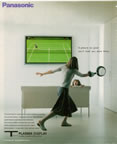
‘Plasma display (Panasonic)’ advertisement is a perfect example of scientific realism. The advertisement pictures a woman pretending to play tennis with a Plasma TV-set, which points out at the fact that image quality of the display is so high that its picture seems to be real. It also emphasizes the gap which exists between fiction and reality (Rubenstein 2008), but, what is more important, it shows the attempt (presumably successful) to bridge this gap and eliminate all the possible bounds between fictional and real world. This representation has quite a close link to the reality because fact is openly opposed to fiction (binary opposition) with the essence of the advertisement lying on the surface.
Ad 2
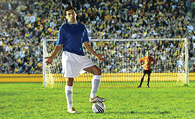
This advertisement shows principles of scientific realism for it makes TV characters alive to some extent. The aim of this advertisement is to show that recording football matches and the like events is possible with LG’s new Plasma TV with built-in DVR. Principles of scientific realism are expressed through picturing football players waiting for a viewer to finish everything he/she is busy with before starting a match. As the advertisement states, now this is possible due to LG’s technological advancements. Such a representation helps to trace relationships between fact and fiction. Using a commonsense approach, it is possible to state that fact, in this case, is superior to fiction because, though the representation is quite real, it still makes the viewer think that the reality (what he/she has to do instead of watching the football match) is more important than fiction.
Changing of this advertisement into the opposite one will alter its meaning as well. Thus, for instance, presenting a person in business clothes hurrying to the TV but not catching the football match live will depict only reality. The meaning of such an advertisement will be that even technologies cannot make wonders and this person will not be able to watch football match live because turning back time is impossible. Such an advertisement could be used to show what happens if a person does not have a TV with a built-in DVR. It can precede the original advertisement, thus showing how the bounds between fiction and reality can be eliminated with new Plasma TV with built-in DVR specially designed by the LG Company for those who value time.
Ad 3
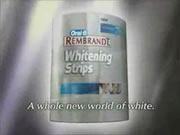
‘Oral B Whitening Strips’ advertisement can be regarded as an example of simulation in health care. It makes the viewer imagine the model of how perfectly white teeth look like. Advertisements are there for people to buy products (Ryan, Gasparski, Enderle 2000) and simulation is the best way to influence consumers’ choice and convince them that they need a specific product (Train 2003). When viewing the advertisement of Oral B Whitening Strips, a person starts thinking whether his/her teeth are white enough to do without those strips. In this case, this person views him/herself as a model of the advertisement comparing teeth whitened with this product and those which he/she has. Thus, this advertisement is an example of simulation because it helps the viewer evaluate and understand the reality.
Ad 4
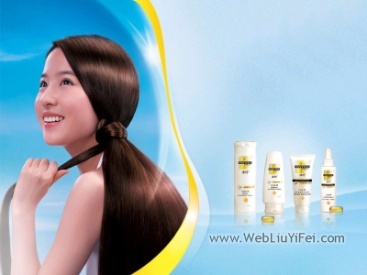
This Pantene Shampoo advertisement is an example of simulation. One of the greatest reasons to consider it as such is that it determines how the viewer perceives the reality. Thus, a woman (and it is mostly women who will get interested in this product) when viewing this advertisement will start thinking over the current state of her hair and compare it with what the advertisement presents. Another step for this woman will be to decide whether she is satisfied with her hair and whether she could use hers in advertising. Preoccupation with this issue will make her buy the product, which is the primary purpose of this advertisement. This is how this advertisement may serve as simulation.
Altering of the meaning of this advertisement is similar to that with LG Plasma TVs. The advertisement would not have been effective if it pictured a young woman with split faded hair, unless such an advertisement preceded the original one. If such a person would have been represented on the original advertisement of the shampoo, this would have hardly attracted attention to the product. The simulation in this case would and on women viewers imagining them in this advertisement and making the conclusion that, if this shampoo is unlikely to change the condition of hair, than there is not need to replace the old one which gives the same results. In other words, there is no sense in buying the product if it does not promise (at least promise) any improvements. Such an advertisement would be a simulation, though without any sense.
Ad 5
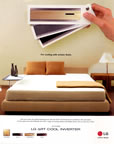
‘LG Art Cool Converter’ advertisement may be believed to express modernism’s rationality because it calls the consumers to explore this device and become the controllers of the temperature at home regardless the weather outside. This advertisement points at the rationality of choice in case the consumer opts to purchase this cool converter. It invites the viewers to discover a new world by means of this modern technology and make sure that this world is much better than the one they are living in. If viewed from theological approach, this advert is also modernistic because it emphasizes the ability of a person to change natural processes (to be in charge of weather in this case) making this person feel that these processes are out of God’s control, which emphasizes the progress of humanity.
Ad 6
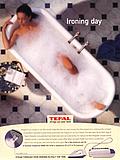
This TEFAL advertisement is a bright example of modernism’s rationality for it expresses human victory over the daily routine a person should go through. Though the advertisement may be gender discriminating to some extent (women may claim that not only they should do ironing), it still achieved its primary purpose, namely proved the world that ironing with TEFAL products may make this process so fast and easy that a person will have plenty of time for personal needs. Modernism’s rationality is achieved through representing a woman who takes a break from house chores because she has TEFAL iron (or at least the fictional character does). This advert induces the viewer purchase the product if he/she does not have one with the main reason being that this product is more modern than the one which the viewer already has; it is by this fact that a person will be guided when making choice.
Changing this advertisement so that it could have opposite meaning is easy. However, picturing a woman that does ironing and looks tired at this is likely to cause more criticism on the part of feminists than the image of a woman resting in a bath while technologies do work for her. Such a representation will not only be more conservative, but it will point at the fact that the society is not progressing, which disagrees with the principles of modernism. In addition, this would mean that the nature conquered humanity making people slaves of the routine, which is also unacceptable in case with modernism.
Ad 7

The meaning of this advertisement can be presented by means of associations. The first association is that this man is running away from his problems by hiding his head like the ostriches do when they are scared (Tetz 2003). Avoiding cholesterol is possible only when a person keeps to a strict diet (Otten, Hellwig, & Meyers 2006) this is why this problem is so widespread. This man helps to turn attention to this problem for his hiding his head means that he already has this problem and cannot find a solution to it. He wishes he had started keeping to the necessary diets earlier so that his problems were not so big now. He experiences fear, sorrow, desperateness, desire to turn back time, and unwillingness to die from a heart attack which high level of cholesterol may cause (Castelli 2007).
Ad 8
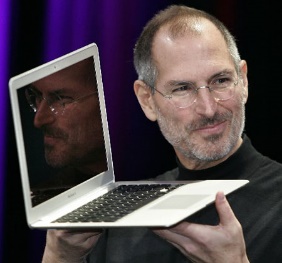
This is Apple’s advertisement of new MacBook Air which began to be sold in February 2009. Quite a great amount of information can be obtained from the facial expression of a man depicted in the advert. At first glance, he seems to be happy presenting this model of a lap top. However, a deeper look into his eyes and his raising his right eyebrow testifies to the fact that he has just finished his speech regarding the presentation of this new model and is waiting for people’s appraisal of his speech. He seems to have been looking for somebody in the crowd of people who came to the presentation; now he has finally found that person and looks at her with self-satisfaction and confidence for he knew from the beginning that designing this model would be worth it, though it does not differ much from the one presented in October last year.
The meaning of this advertisement will be changed if the man’s facial expression is also changed. Thus, showing only the MacBook without representing a person in the advert would make it impersonal, dry, and unclear. Those viewers who are aware about Apple’s products would perhaps know something about this model, but it still would be difficult to state whether it was approved by the public or whether its presentation was unsuccessful. None of the associations would be possible to make in this case but for the one, that this is just another model of Apple’s MacBook.
Ad 9
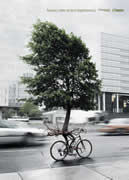
This advertisement depicts a tree riding a bicycle down one of the streets of a great mega polis. The tree bends forward instead of bending backward, which would happen if the speed was high. This gives an idea that the bicycle has stopped suddenly to turn people’s attention to the fact that there are only a few other trees (at the background) at this street. Cars are rushing by without even making any attempts to stop; this shows that not many of the citizens care about the live green campaign and the air they breathe. This advert expresses human indifference to the nature in the modern world of technological development (Redner 2001), as well as an idea that trees, just like people in cars driving the street, have a right for existence.
Ad 10
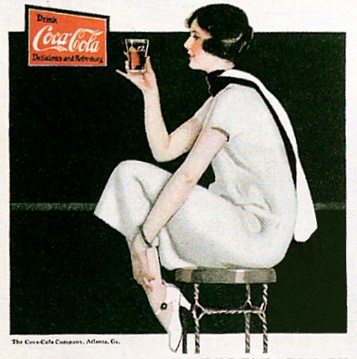
This is the Coca-Cola advertisement performed in the style of the 1960s or 1970s. The picture is almost black-and-white, but it is not the color of the picture that is expressive in case with this advertisement. The lady is dressed in white dress; she has white shoes and black scarf on her as well with her dark-brown hair being perfectly done; this means that her life is nothing but black-and-white. It is tasteless and boring, mostly because it is perfect. She is depicted at the background of a plain black wall which emphasizes her dejection. Sudden red sign of the Coca-Cola Company diversifies the advert. The woman took a glass of Coca-Cola in her hand and her cheeks turned pink at once. She is looking at it with suspicion as if thinking whether it may do any harm to her. However, her enigmatic smile shows that she is ready to take risks.
The meaning of the advert would be completely different if the sense has not been hidden so deeply. If it was a colorful picture with people dancing and drinking the Coke, this would have hardly turned any attention to how special and unique this drink is. Contrasting bright and unexpected taste of Coca-Cola with a well-balanced and predictable life of the woman in white clothes makes the drink even more special. Representing it amidst other bright subjects and people in an extremely colorful picture would distract attention from the essence, the fact that no one has ever succeeded in copying the taste of Coca-Cola.
References
- Castelli, WP 2007, Cholesterol Cures (revised): Featuring the Breakthrough Menu Plan to Slash Cholesterol by 30 Points in 30 Days, Rodale, London.
- Otten, JJ, Hellwig, JP & Meyers, LD 2006, DRI, dietary reference intakes: the essential guide to nutrient requirements, National Academies Press, Washington, D.C.
- Redner, H 2001, Ethical life: the past and present of ethical cultures, Rowman & Littlefield, London.
- Rubenstein, D 2008, This is not a president: sense, nonsense, and the American political imaginary, NYU Press, New York.
- Ryan, LV, Wojciech, G & Enderle, G 2000, Business students focus on ethics, Transaction Publishers, New Brunswick and London.
- Tetz, RC 2003, God’s big idea: primary devotional, Review and Herald Pub. Assoc., Washington, D.C
- Train, K 2003, Discrete choice methods with simulation, Cambridge University Press, Cambridge.